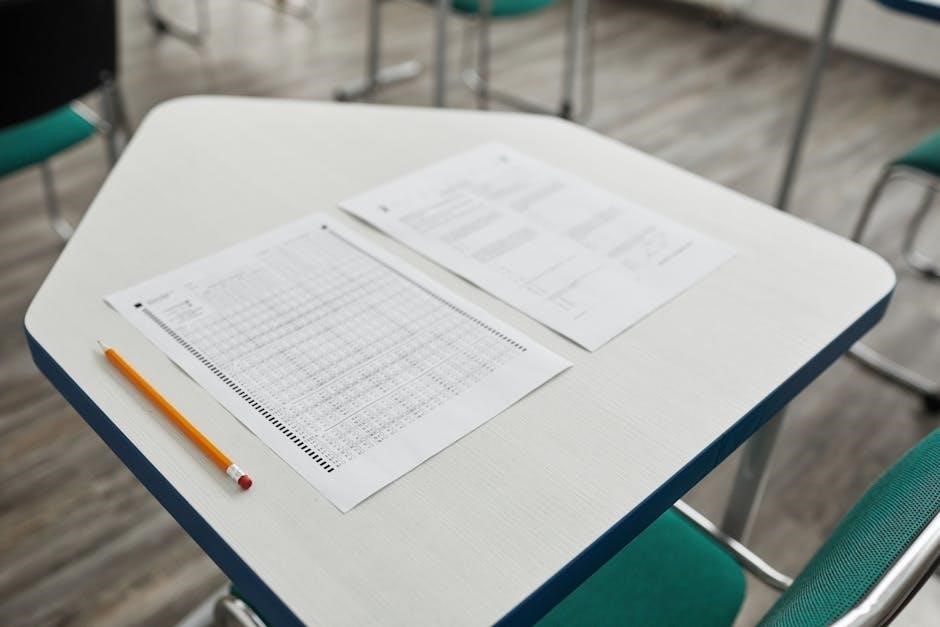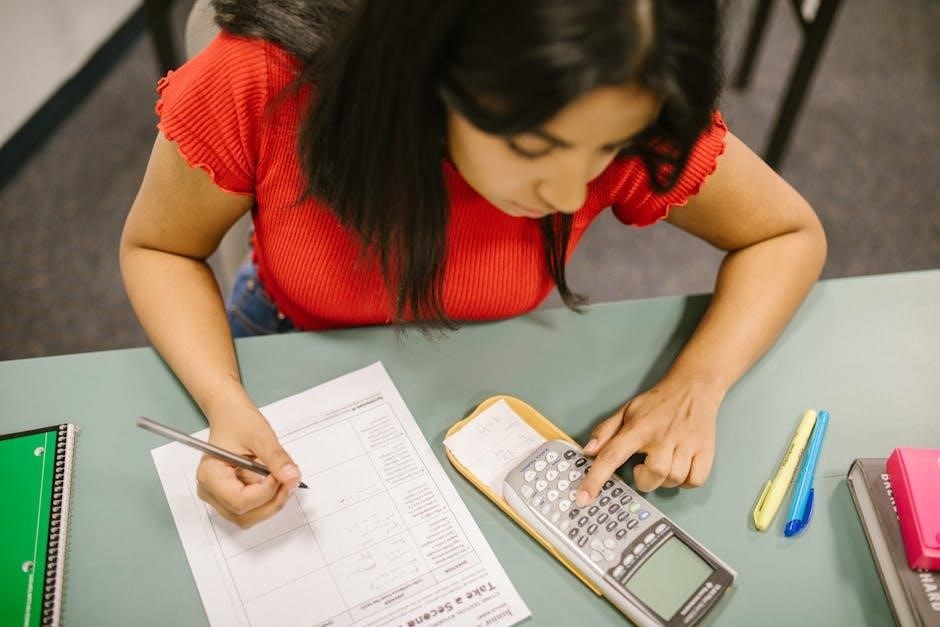Year 7 maths tests assess understanding of key concepts like numeracy, algebra, geometry, and statistics. Available in PDF format, these tests cover various topics and provide comprehensive practice for students to prepare effectively.
Understanding the Structure of Year 7 Maths Tests
Year 7 maths tests are designed to assess students’ understanding of key mathematical concepts and skills. Typically, these tests are divided into sections, covering topics such as numeracy, algebra, geometry, and statistics. The format often includes multiple-choice questions, short-answer problems, and extended-response questions to evaluate a range of abilities. Tests may also incorporate visual elements like graphs, charts, or diagrams to test spatial awareness and interpretation skills. Instructions usually specify the use of pens or pencils, prohibit calculators, and require students to show their working. Tests are often based on the Australian Curriculum, ensuring alignment with learning objectives. The structure allows for a mix of straightforward and challenging questions, helping teachers identify areas where students may need additional support. Clear guidelines and time limits prepare students for formal assessments in higher grades.

Key Topics Commonly Assessed in Year 7 Maths Tests
Year 7 maths tests cover numeracy, algebra, geometry, and statistics, focusing on factors, multiples, decimals, and percentages, with questions designed to evaluate understanding and procedural skills.
Numeracy and Procedural Fluency
Numeracy and procedural fluency are foundational skills assessed in Year 7 maths tests. Students are expected to demonstrate accuracy in basic arithmetic operations, including multiplication, division, addition, and subtraction. Key topics include factors, multiples, and mental maths strategies. Procedural fluency involves solving problems step-by-step, such as long division and multi-digit multiplication. Tests often include questions on decimals, percentages, and money calculations to evaluate real-world application. Practice materials provide exercises to reinforce these skills, ensuring students can apply them confidently. Mastering numeracy and procedural fluency is essential for progressing to more complex mathematical concepts.
Algebra and Equations
Algebra and equations are critical components of Year 7 maths tests, focusing on solving linear and quadratic equations. Students are required to simplify expressions, solve for variables, and graph basic equations. Key topics include understanding inverse operations, balancing equations, and applying algebraic methods to real-world problems. Practice tests often feature multiple-choice and short-answer questions to assess these skills. For example, solving equations like (3x + 5 = 20) or simplifying expressions such as (2(4x ー 3)). Resources like PDF materials provide detailed examples and exercises to help students master algebraic techniques. Accurate working and logical steps are essential for achieving high marks in this section.
Geometry and Spatial Awareness
Geometry and spatial awareness are essential skills assessed in Year 7 maths tests, focusing on understanding shapes, properties, and relationships. Students are expected to identify and classify different types of triangles, quadrilaterals, and polygons, as well as calculate perimeter, area, and volume. Key topics include properties of angles, symmetry, and the use of geometric theorems like Pythagoras. Spatial awareness involves interpreting 2D representations of 3D objects and visualizing nets of solids. Practice tests often include multiple-choice questions and diagrams requiring precise measurements or identifications. Resources like PDF guides provide exercises on calculating missing angles in triangles or proving geometric properties. Accurate diagrams and clear explanations are crucial for mastering this section.
Statistics and Probability
In Year 7 maths tests, statistics and probability questions assess students’ ability to collect, interpret, and analyze data, as well as understand chance events; Key topics include creating and reading bar graphs, line graphs, and pie charts to identify patterns and trends. Students are also expected to calculate probabilities of simple events, such as flipping a coin or rolling a die, and understand concepts like fairness and likelihood. Probability questions often involve comparing experimental results with theoretical predictions, ensuring students can apply mathematical reasoning to real-world scenarios. Practice tests in PDF formats frequently include word problems requiring data interpretation and probability calculations, helping students build confidence in these essential skills.

Revision Strategies for Year 7 Maths Tests
Effective revision involves focused practice, consistent review, and understanding key concepts. Utilize past papers, flashcards, and digital tools to reinforce learning. Regular short sessions improve retention and confidence.
Creating a Study Schedule
Creating a structured study schedule is essential for effective preparation. Start by identifying key topics and allocating specific time slots for each area. Break your study sessions into manageable chunks, focusing on one topic at a time to avoid confusion. Set clear, achievable goals for each session, such as mastering a particular concept or completing a set of practice questions. Ensure a balance between numeracy, algebra, geometry, and statistics to cover all areas. Incorporate regular breaks to maintain focus and prevent burnout. Use a planner or digital calendar to stay organized and track progress. Review and adjust your schedule weekly to reflect your strengths and weaknesses, ensuring consistent improvement. A well-planned schedule helps build confidence and reduces exam anxiety, keeping you on track for success.
Using Practice Tests Effectively
Practice tests are a valuable tool for preparing for Year 7 maths tests. They help identify areas where you need improvement and familiarize you with the test format. Start by simulating real test conditions, such as timing yourself and working without distractions. This builds time management skills and exam stamina. After completing a test, review your answers to understand mistakes and learn from them. Focus on weak areas by revisiting relevant topics. Use official or reliable test papers, such as those found in a Year 7 maths test PDF, to ensure the questions align with the curriculum. Regular practice tests help track progress, boost confidence, and reduce anxiety. Over time, you’ll develop strategies to tackle challenging questions more effectively. Consistent use of practice tests is key to achieving success in your maths assessments.
Understanding Key Concepts
Understanding key concepts is essential for success in Year 7 maths tests. Focus on building a strong foundation in areas like fractions, decimals, algebra, and geometry. Start by breaking down complex problems into simpler steps, ensuring clarity at each stage. Use visual aids, such as diagrams or graphs, to help grasp abstract ideas. Regularly revisit and practice core concepts to reinforce your understanding. Apply these concepts to real-world scenarios to deepen your comprehension. If a topic feels challenging, seek guidance from teachers or tutors. Utilize Year 7 maths test PDF resources to find examples and exercises that align with the curriculum. By mastering key concepts, you’ll approach tests with confidence and improve your ability to solve a wide range of problems effectively.

Practice Questions and Resources
Access Year 7 maths test PDFs for practice, featuring multiple-choice and open-response questions. Utilize online platforms and educational websites for comprehensive study materials and past papers.
Multiple-Choice Questions
Multiple-choice questions (MCQs) are a key component of Year 7 maths tests, often included in downloadable PDF resources. These questions test quick recall and understanding of concepts like numeracy, algebra, and geometry. Many Year 7 maths test PDFs feature MCQs covering topics such as fractions, decimals, and basic equations. Students can benefit from practicing these questions to improve speed and accuracy. MCQs also help identify gaps in knowledge, allowing targeted revision. When using Year 7 maths test PDFs, focus on reviewing answers and explanations to reinforce learning. Regular practice with MCQs builds confidence and familiarity with test formats. Additionally, many educational websites offer free Year 7 maths test PDFs with MCQs, making them accessible for home study or classroom use.
Short-Answer and Extended-Response Questions

Short-answer and extended-response questions are essential components of Year 7 maths tests, often featured in downloadable PDF resources. These questions require students to provide detailed explanations and solutions, showcasing their problem-solving skills and understanding of mathematical concepts. Short-answer questions typically ask for concise explanations or calculations, while extended-response questions demand more comprehensive solutions, often spanning multiple steps. Both formats are designed to assess critical thinking and the ability to communicate mathematical ideas clearly. Year 7 maths test PDFs frequently include these question types to evaluate depth of knowledge in areas like algebra, geometry, and statistics. Practicing these questions helps students develop the ability to articulate their reasoning effectively and prepare for more challenging assessments in higher grades.
Online Resources and PDF Materials
Online resources and downloadable PDF materials are invaluable for preparing for Year 7 maths tests. Websites like Khan Academy, BBC Bitesize, and specific educational portals offer a wealth of practice tests, worksheets, and study guides in PDF format. These resources are designed to align with curriculum standards, covering key topics such as numeracy, algebra, geometry, and statistics. Many schools and educational platforms provide free downloadable PDFs that include sample questions, model answers, and revision tips. These materials are particularly useful for self-study, allowing students to practice at their own pace and review their progress. Additionally, some websites offer interactive PDFs with fillable answer spaces, making it easier for students to simulate test conditions and improve their performance; Utilizing these resources can significantly enhance test readiness and confidence.

Test Instructions and Guidelines
Read all instructions carefully, ensure proper use of allowed materials, and manage time effectively. Answer all questions clearly, show calculations, and check work before submitting.

General Instructions for Test-Takers
Read the test carefully and follow all instructions provided. Ensure you use only allowed materials, such as pens, pencils, and calculators, as specified. Allocate time evenly across all questions to avoid rushing. Write your name and student ID clearly on the test paper. Answer each question in the space provided, and if you need to show working, do so neatly. For multiple-choice questions, circle your answers clearly. If you make a mistake, cross it out neatly and rewrite. Do not leave questions blank; attempt all parts to maximize your score. Stay calm and manage your time wisely to complete the test effectively. Ensure all answers are legible and easy to read. Double-check your work before submitting the test. Good luck!
Allowed Materials and Equipment
Students are typically permitted to use pens, pencils, erasers, rulers, and calculators during Year 7 maths tests. Ensure calculators are basic models without programmable functions. Mobile phones and smartwatches are generally not allowed. Some institutions may allow geometry sets for drawing precise shapes. Check with your teacher or the test instructions for specific materials allowed. Equipment requirements may vary between schools or test providers. It is essential to confirm allowed items beforehand to avoid discrepancies. Remember, some tests may not permit calculators, so practice mental maths and basic arithmetic. Always bring spare pens and pencils to avoid running out during the test. Clear plastic water bottles are usually permitted but check for any restrictions. Be prepared and organized with all necessary materials to ensure smooth test-taking.
Time Management Strategies
Effective time management is crucial for success in Year 7 maths tests. Allocate time evenly across all questions, spending around 1-2 minutes per question for shorter problems and 3-5 minutes for longer ones. Start by skimming through the entire test to identify easier questions and tackle them first. This approach builds confidence and saves time for more challenging problems later. Avoid spending too long on a single question; move on and return if time permits. Use the last 5 minutes to review answers, check calculations, and ensure all questions are attempted. Prioritize questions worth more marks to maximize scores. Practice timing during study sessions to improve speed and accuracy. Stay calm and systematic to make the most of the available time.

Common Mistakes to Avoid
Common mistakes in Year 7 maths tests include rushing through questions, misreading instructions, and miscalculations. Students should take time to read carefully and double-check their work.
Understanding Question Requirements
Understanding what each question is asking is crucial for success in Year 7 maths tests. Students often make mistakes by misreading instructions or failing to identify key terms. To avoid this, encourage them to read each question slowly and carefully. Highlighting or underlining important words can help focus their attention. For example, words like “show,” “prove,” or “calculate” indicate specific actions required. Many questions also include diagrams or charts, so understanding how to interpret these is essential. Additionally, students should pay attention to units of measurement and whether the question asks for a numerical answer or an explanation. Taking a moment to plan their approach before writing ensures they address all parts of the question. This skill improves with practice, so regular test preparation is recommended.
Showing Working and Calculations
Showing working and calculations is a critical skill for Year 7 maths tests, as it demonstrates understanding and allows for partial credit. Students should always write down their thought process, even for seemingly simple questions. Breaking down problems into smaller steps helps clarify thinking and reduces errors. Using clear, legible handwriting ensures that markers can follow the reasoning. Highlighting key steps, such as formulas or key operations, makes it easier to review work. Encouraging students to check their calculations by retracing their steps or using alternative methods builds confidence and accuracy. Teachers often emphasize that neat, organized working out is as important as the final answer; Regular practice with showing working helps students develop this habit, improving their performance in tests and exams. This approach also prepares them for higher-level maths, where detailed solutions are often required.


Support for Parents and Teachers
Support for Parents and Teachers is essential for student success. Providing resources like study guides and practice tests helps parents and educators prepare students effectively.
How Parents Can Help Prepare Students
Parents play a crucial role in preparing students for Year 7 maths tests. Creating a dedicated study space and encouraging regular practice with resources like the Year 7 Maths Test PDF can significantly enhance a child’s readiness. Establishing a consistent study routine helps build confidence and fluency in problem-solving. Open communication with teachers ensures parents are aware of their child’s strengths and areas needing improvement. Positively reinforcing efforts and progress fosters a supportive learning environment. Parents should also discuss test formats and time management strategies to reduce anxiety. Encouraging children to ask questions and seek clarification on difficult topics is vital. By setting realistic goals and celebrating achievements, parents can help their child approach the test with confidence and a positive mindset.
Teacher Resources and Lesson Plans
Teachers can effectively prepare students for Year 7 maths tests by utilizing a variety of resources and structured lesson plans. Incorporating the Year 7 Maths Test PDF into classroom activities ensures students are familiar with test formats and question types. Lesson plans should focus on reinforcing key concepts, such as numeracy, algebra, and geometry, through interactive and engaging activities. Teachers can also use online platforms and educational software to supplement traditional teaching methods. Providing students with practice worksheets and past papers helps build their problem-solving skills and time management abilities. Additionally, incorporating group work and collaborative problem-solving activities encourages peer learning and deeper understanding. By aligning lessons with test requirements, teachers can ensure students are well-prepared and confident for their assessments.
Preparing for Year 7 maths tests requires a combination of consistent practice, understanding of key concepts, and effective time management. Using resources like the Year 7 Maths Test PDF can help students familiarize themselves with test formats and improve their problem-solving skills. Encourage regular revision, starting with weaker areas and gradually building confidence in all topics. Practicing under timed conditions and reviewing mistakes are essential strategies for success. Stay calm during the test, read questions carefully, and ensure all steps are shown. Seeking help from teachers or tutors when needed is crucial. With dedication and the right approach, students can achieve their best results. Remember, consistent effort and positive mindset are key to excelling in maths tests.
